According to WEKA's 2023 Global Trends in AI Report, 69% of organizations now have AI projects up and running, and 28% are using AI across their whole business. This shows a big move from just trying out AI to making it a key part of how companies operate and succeed.
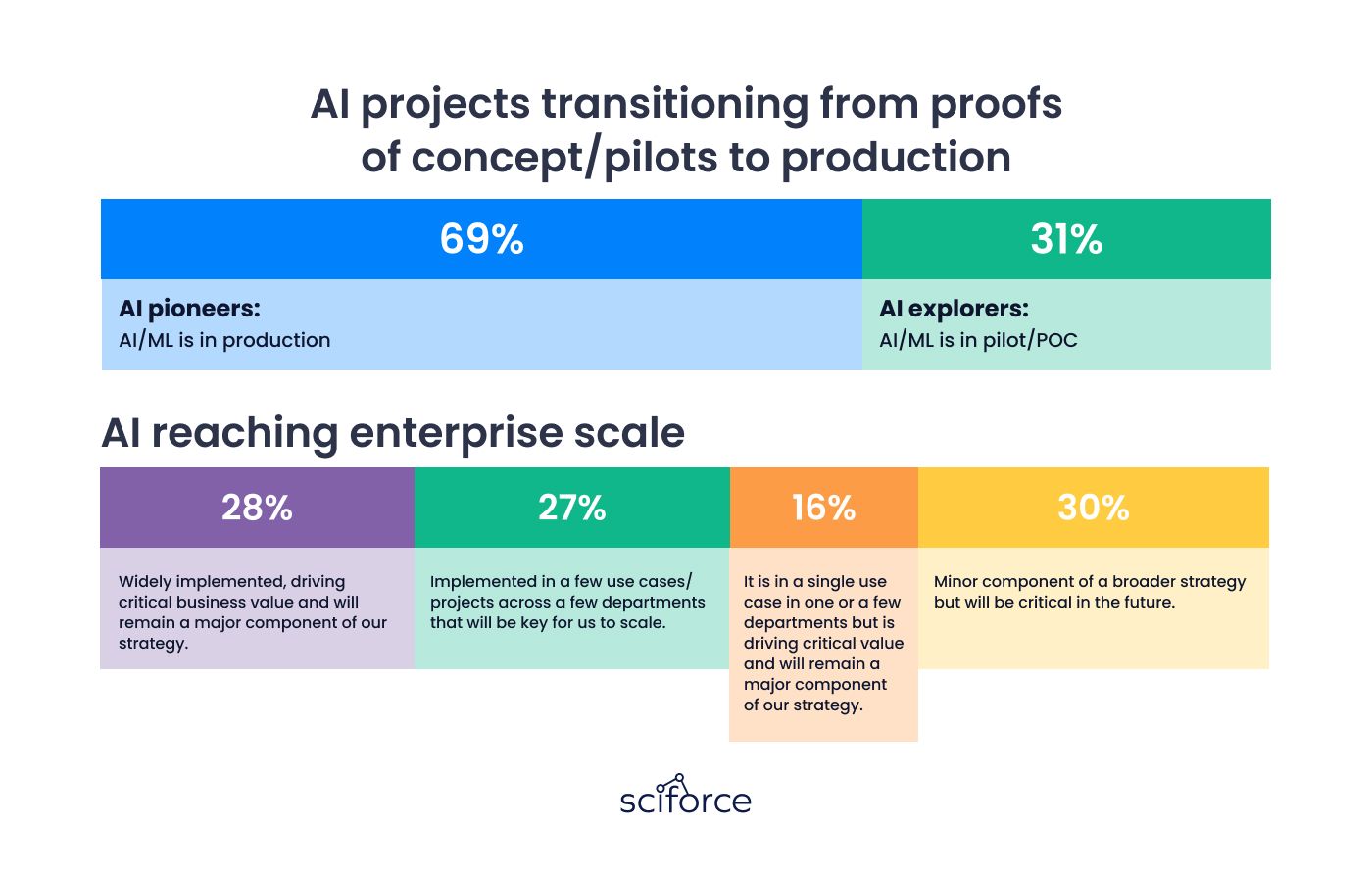
However, this is just the beginning as the major point is not to have only AI but to have it work to your benefit. Organizations have to address various challenges such as the collection of data, hiring the right skills, and fitting AI into their existing system. This guide serves both new companies and big businesses. It gives you clear examples and direct advice on how to work around these problems.
We will discuss what specific things you can do to make the most of AI, whether you want to improve your processes, give better customer service, or make better business decisions. We could help you not only to use AI but to make the best use of it to lead the competition in your area.
Artificial Intelligence (AI) and Machine Learning (ML) are two modern technologies that are restructuring the way businesses work. The AI study by 451 Research data has revealed that most companies start using AI/ML not just to cut expenses but to generate revenue as well. They are using AI/ML to revamp their profit systems, sharpen their sales strategies, and enhance their product and service offerings. This demonstrates the change of viewpoint, AI/ML becoming a driver of business growth and not just a hands-on tool.
For integrating AI in your business to be effective, you need to have clear goals and plans of implementation. We have put together a short guide to get you started in a smart direction for your business.
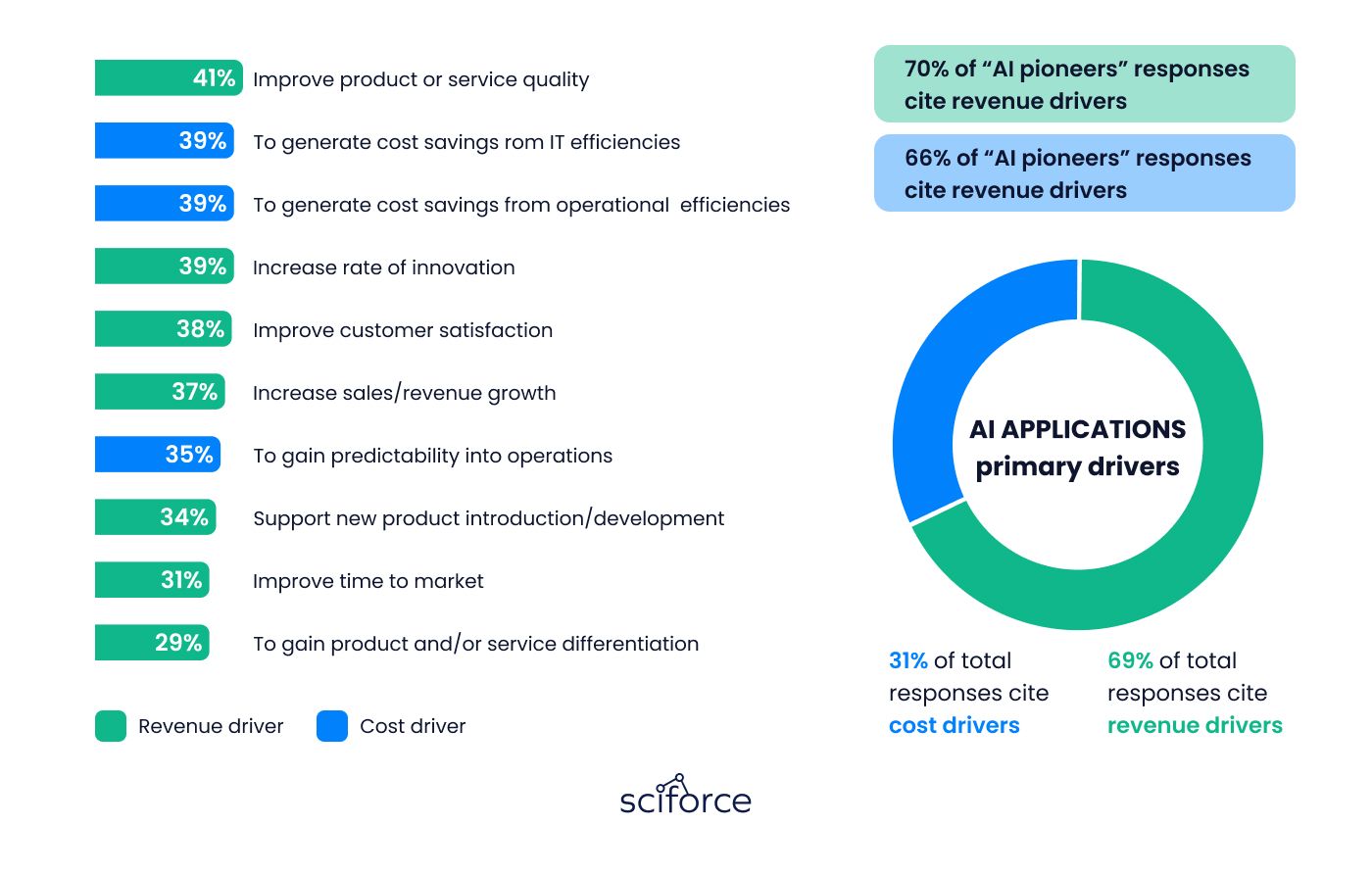
1. Identify Objectives
The first step in your AI integration is clearly stating your goals. This can be:
Having clear goals helps shape your AI strategy and actions. This ensures your AI projects align closely with your broader business aims, creating a solid foundation for achieving tangible success.
2. Assess Your Current Setup
It's important to note that about 80% of AI projects don't move past the testing phase or lab setup. This often happens because standardizing the way models are built, trained, deployed, and monitored can be tough. AI projects usually need a lot of resources, which makes them challenging to manage and set up. However, this doesn't mean small businesses can't use AI. With the right approach, even smaller companies can make AI work for them, effectively bringing it into their operations.
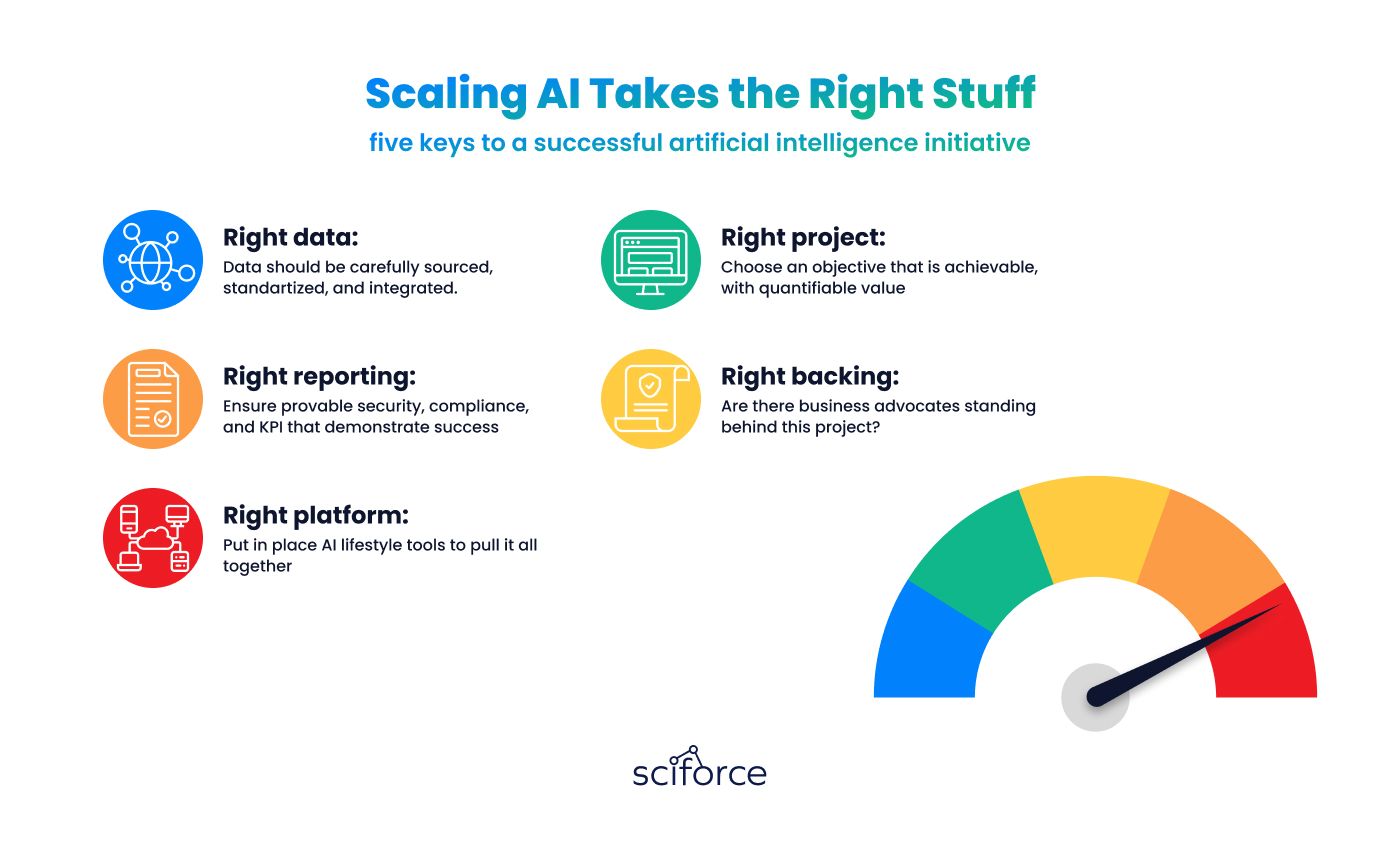
Computational Resources
AI models, especially those using machine learning or deep learning, need a lot of computing power to work well to process large datasets. This is important for training the AI, doing calculations, and handling user queries in real-time.
Small businesses that don't have massive infrastructure can choose cloud computing services like AWS, Google Cloud, or Microsoft Azure. They have the necessary hardware and can adjust your performance to your needs.
Data Quality and Quantity
AI requires access to a lot of clean and organized data that is essential for training AI to identify patterns, make correct predictions, and answer questions. Collecting and preparing this kind of high-quality, error-free data in large amounts can be difficult, often taking up to 80% of the time from the start of the project to its deployment. For businesses that don’t have massive amounts of structured data, the solutions can be as follows:
Expertise
Effective AI implementation requires a strong team capable of creating algorithms, analyzing data, and training models. It involves complex math and statistics and advanced software skills like programming in Python or R, using machine learning frameworks (e.g. TensorFlow or PyTorch), and applying data visualization tools.
For businesses that can't afford to gather and maintain a professional AI team, the solution is to partner with niche companies that focus on AI development services, like SciForce. Specialized service providers have the necessary technical skills and business experience that allow them to create tailored AI solutions for your needs.
Integration
Integrating AI into existing business operations requires planning to ensure smooth incorporation with current software and workflows, avoiding significant disruptions. Challenges include resolving compatibility, ensuring data synchronization, and maintaining workflow efficiency as AI features are introduced.
To overcome integration challenges, choose AI solutions with easy compatibility with standard business software, focusing on those with APIs and SDKs for seamless integration. Prefer AI platforms with plug-and-play features for CRM and ERP systems. SciForce offers integration services, specializing in AI solutions that integrate effortlessly with existing software, hardware, and operations with zero disruptions.
Ongoing Maintenance and Updates
Before engaging in the implementation of AI solutions in the company, remember that AI systems need regular updates, including consistent data stream and software improvements. This helps AI adapt, learn from new inputs, and stay secure against threats.
Creating AI from scratch, you will need a permanent internal team to maintain it. If you opt for an out-of-the-box solution, the vendor will deliver automatic updates. Partnering with SciForce, you receive managed AI services with our professionals handling the maintenance and updates of your system.
3. Choose Your AI Tools and Technologies
With a variety of AI/ML tools available in the market, it’s hard to choose the one that will suit your needs, especially if it’s your first AI project. Here we asked our ML experts to share top tools they use in their everyday work.
Databases
AI\ML can’t exist without databases that are the foundation for data handling, training, and analysis. SciForce top choice is Qdrant, a specialized vector database, that excels in this role by offering flexibility, high performance, and secure hosting options. It's particularly useful for creating AI assistants using organizational data.
It allows for storing additional details alongside vectors, improving data handling, filtering, and analysis.
Machine Learning
Here is our top choice of the tools that allow us to easier AI model management and deployment.
Speech Processing Frameworks
These tools help our team to refine voice recognition and teach computers to understand human language better.
Large Language Models
There are lots of tools for working with LLMs, but many of them are complex inside and not straightforward. Yet, our team picked some tools for you that simplify working with LLMs:
Data Science
Our Data Science team considers the DoWhy library a valuable tool for causal analysis. It helps to analyze and work with data in more depth, focusing on the cause-and-effect connections between different elements:
It provides exceptionally clear data insights, however requires a lot of computational power.
4. Start Small and Scale Gradually
Begin with small AI projects to see what works best for your business. Learn from these projects and gradually implement more complex AI solutions.
- Be focused
Start with a small, well-defined AI project that addresses a specific business need or pain point. This could be automating a single task or improving a specific process. Define clear, achievable objectives for your initial AI project. This helps in measuring success and learning from the experience.
- Gather a cross-functional team
Assemble a team with diverse skills, including members from the relevant business unit, IT, and the ones with specific AI skills you need. This ensures the project benefits from different perspectives. You can also turn to a service provider with relevant expertise.
- Use Available Data
Begin with the data you already have. This approach helps in understanding the quality and availability of your data for AI applications. In case you lack data, consider using public datasets or purchasing ones.
- Scale Based on Learnings
Once you have the first results, review them and plan your next steps. To achieve your first goals, you can plan to expand the scope of AI within your business.
- Build on Success
Use the success of your initial projects to encourage the wider use of AI in your organization. Share what worked and what you learned to get support from key decision-makers.
- Monitor and Adjust
In managing AI initiatives, it's critical to regularly assess their impact and adapt as needed. Define key performance indicators (KPIs) relevant to each project, such as process efficiency or customer engagement metrics. Employ analytics tools for ongoing monitoring, ensuring continuous alignment with business goals.
Read on to learn how to assess AI performance within your business.
To make the most of AI for your business, it's essential to measure its impact using Key Performance Indicators (KPIs). These indicators help track AI performance and guide improvements, ensuring that AI efforts are delivering clear results and driving your business forward.
1. Defining Success Metrics
To benefit from AI in your business, it's crucial to pick the right Key Performance Indicators (KPIs). These should align with your main business objectives and clearly show how your AI projects are performing:
1. Align with Business Goals Start by reviewing your business objectives. Whether it's growth, efficiency, or customer engagement, ensure your KPIs are directly linked to these goals.
2. Identify AI Impact Areas Pinpoint where AI is expected to make a difference. Is it streamlining operations, enhancing customer experiences, or boosting sales?
3. Choose Quantifiable Metrics Select metrics that offer clear quantification. This might include numerical targets, percentages, or specific performance benchmarks.
4. Ensure Relevance and Realism KPIs should be both relevant to the AI technology being used and realistic in terms of achievable outcomes.
5. Plan for Continuous Review Set up a schedule for regular KPI reviews to adapt and refine your metrics as needed, based on evolving business needs and AI capabilities.
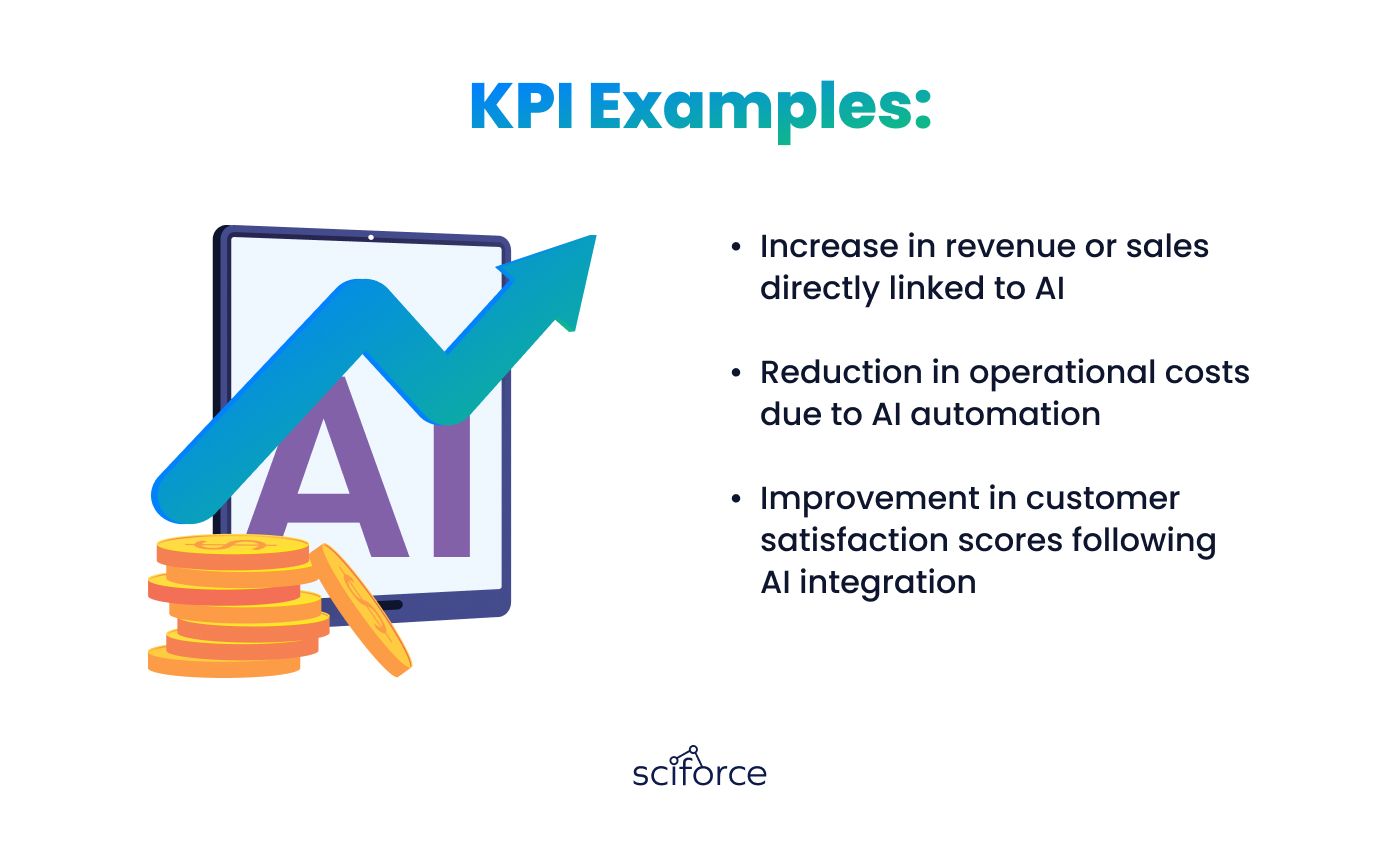
Baseline Measurement and Goal Setting
Record key performance metrics before integrating AI to serve as a reference point. This helps in directly measuring AI's effect on your business, such as tracking improvements in customer service response times and satisfaction scores. Once you have a baseline, set realistic goals for what you want to achieve with AI. These should be challenging but achievable, tailored to the AI technology you're using and the areas you aim to enhance.
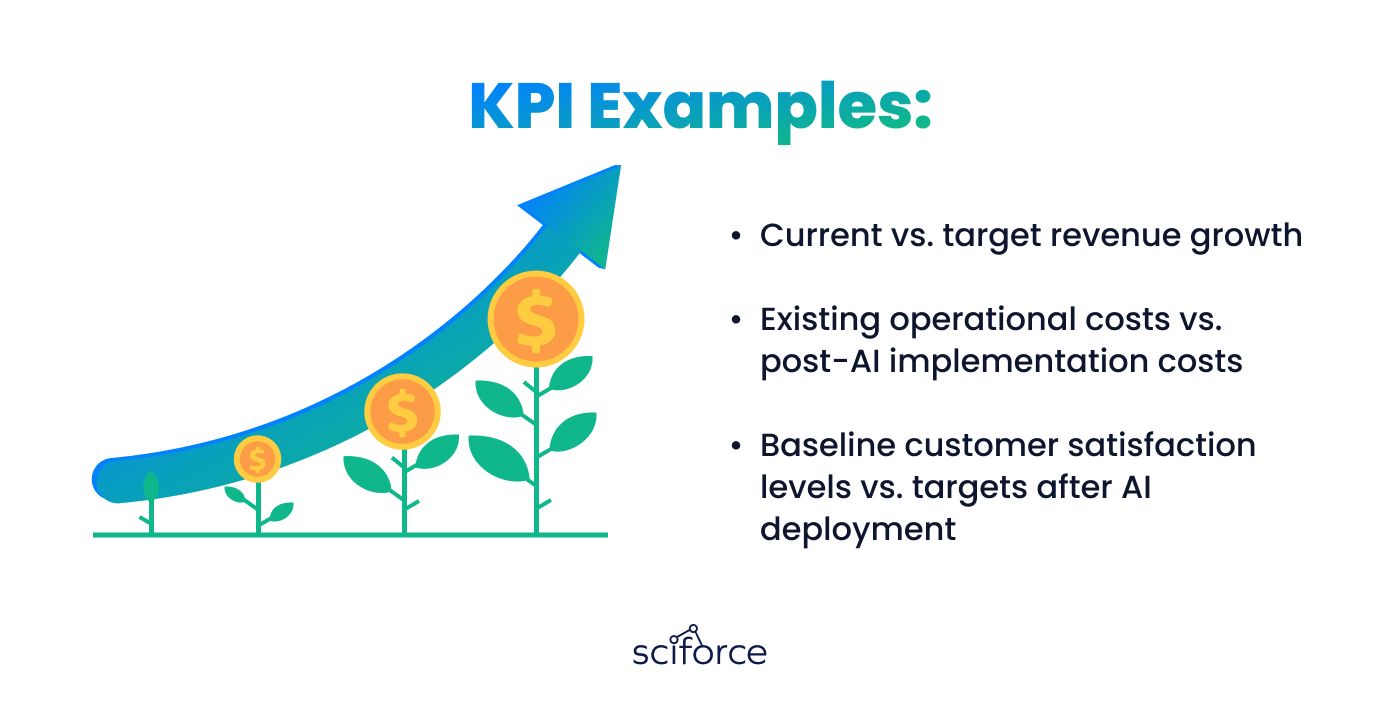
Regular Monitoring and Reporting
Regularly checking KPIs and keeping up with consistent reports is essential. This ongoing effort makes sure AI efforts stay in line with business targets, enabling quick changes based on real results and feedback.
1. Reporting Schedule Establish a fixed schedule for reports, such as monthly or quarterly, to consistently assess KPI trends and impacts.
2. Revenue Monitoring Monitor revenue shifts, especially those related to AI projects, to measure their direct impact on sales.
3. Operational Costs Comparison Analyze operational expenses before and after AI adoption to evaluate financial savings or efficiencies gained.
4. Customer Satisfaction Tracking Regularly survey customer satisfaction, noting changes that correlate with AI implementations, to assess AI's effect on service quality.
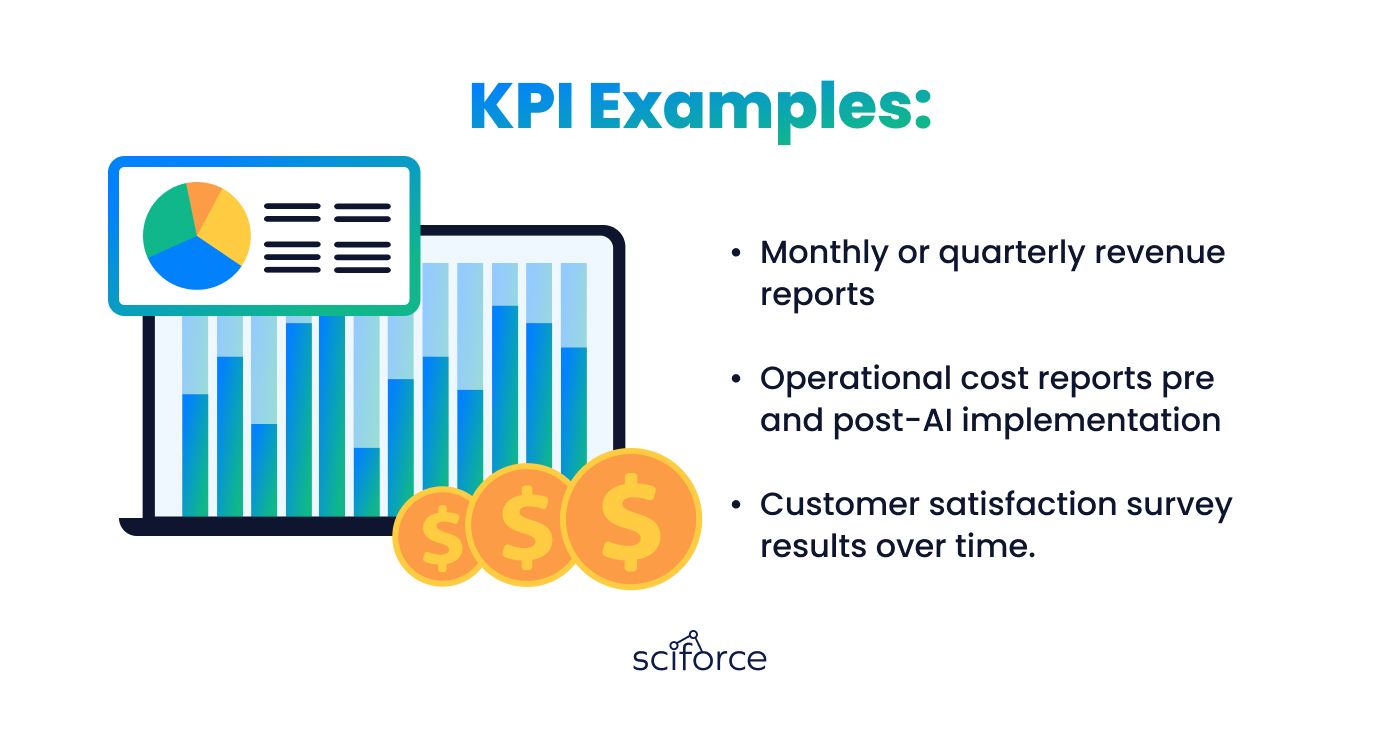
ROI Analysis of AI Projects
Determining the Return on Investment (ROI) of any project is essential for smart investment in technology. Here’s a concise guide to calculating ROI for AI projects:
1. Cost-Benefit Analysis List all expenses for your AI project, such as development costs, software and hardware purchases, maintenance fees, and training for your team. Then, determine the financial benefits the AI project brings, such as increased revenue and cost savings.
2. ROI Calculation Determine the financial advantages your AI project brings, including any increase in sales or cost reductions. Calculate the net benefits by subtracting the total costs from these gains. Then, find the ROI:

3. Ongoing Evaluation Continuously revise your ROI analysis to include any new data on costs or benefits. This keeps your assessment accurate and helps adjust your AI approach as necessary.
Future Growth Opportunities
Use the success of your current AI projects as a springboard for more growth and innovation. By looking at how these projects have improved your business, you can plan new ways to use AI for even better results:
Expanding AI Use Search for parts of your business that haven't yet benefited from AI, using your previous successes as a guide. For example, if AI has already enhanced your customer service, you might also apply it to make your supply chain more efficient.
Building on Success Review your best-performing AI projects to see why they succeeded. Plan to apply these effective strategies more broadly or deepen their impact for even better results.
Staying Ahead with AI Keep an eye on the latest in AI and machine learning to spot technologies that could address your current needs or open new growth opportunities. Use the insights from your AI projects to make smart, data-informed choices about where to focus your AI efforts next.
AI transforms business operations by enhancing efficiency and intelligence. It upgrades product quality, personalizes services, and streamlines inventory with predictive analytics. Crucial for maintaining a competitive edge, AI optimizes customer experiences and enables quick adaptation to market trends, ensuring businesses lead in their sectors.
Computer Vision
Computer Vision (CV) empowers computers to interpret and understand visual data, allowing them to make informed decisions and take actions based on what they "see." By automating tasks that require visual inspection and analysis, businesses can increase accuracy, reduce costs, and open up new opportunities for growth and customer engagement.
- Quality Control in Manufacturing Computer Vision (CV) streamlines the inspection process by quickly and accurately identifying product flaws, surpassing manual checks. This ensures customers receive only top-quality products.
- Retail Customer Analytics CV analyzes store videos to gain insights into how customers shop, what they prefer, and how they move around. Retailers can use this data to tailor marketing efforts and arrange stores in ways that increase sales and improve shopping experiences.
- Automated Inventory Management CV helps manage inventory by using visual recognition to keep track of stock levels, making the restocking process automatic and reducing the need for manual stock checks. This increases operational efficiency, keeps stock at ideal levels, and avoids overstocking or running out of items.
Case: EyeAI – Space Optimization & Queue Management System
Leveraging Computer Vision, we created EyeAI – SciForce custom video analytics product for space optimization and queue management. It doesn’t require purchasing additional hardware or complex integrations – you can immediately use it even with one camera in your space.

- Customer Movement Tracking: Our system observes how shoppers move and what they buy, allowing us to personalize offers, and improve their shopping journey.
- Store Layout Optimization: We use insights to arrange stores more intuitively, placing popular items along common paths to encourage purchases.
- Traffic Monitoring: By tracking shopper numbers and behavior, we adjust staffing and marketing to better match customer flow.
- Checkout Efficiency: We analyze line lengths and times, adjusting staff to reduce waits and streamline checkout.
- Identifying Traffic Zones: We pinpoint high and low-traffic areas to optimize product placement and store design, enhancing the overall shopping experience.
Targeted for HoReCa, retail, public security, healthcare sectors, it analyzes customer behavior and movements and gives insights of space optimization for better security and customer service.
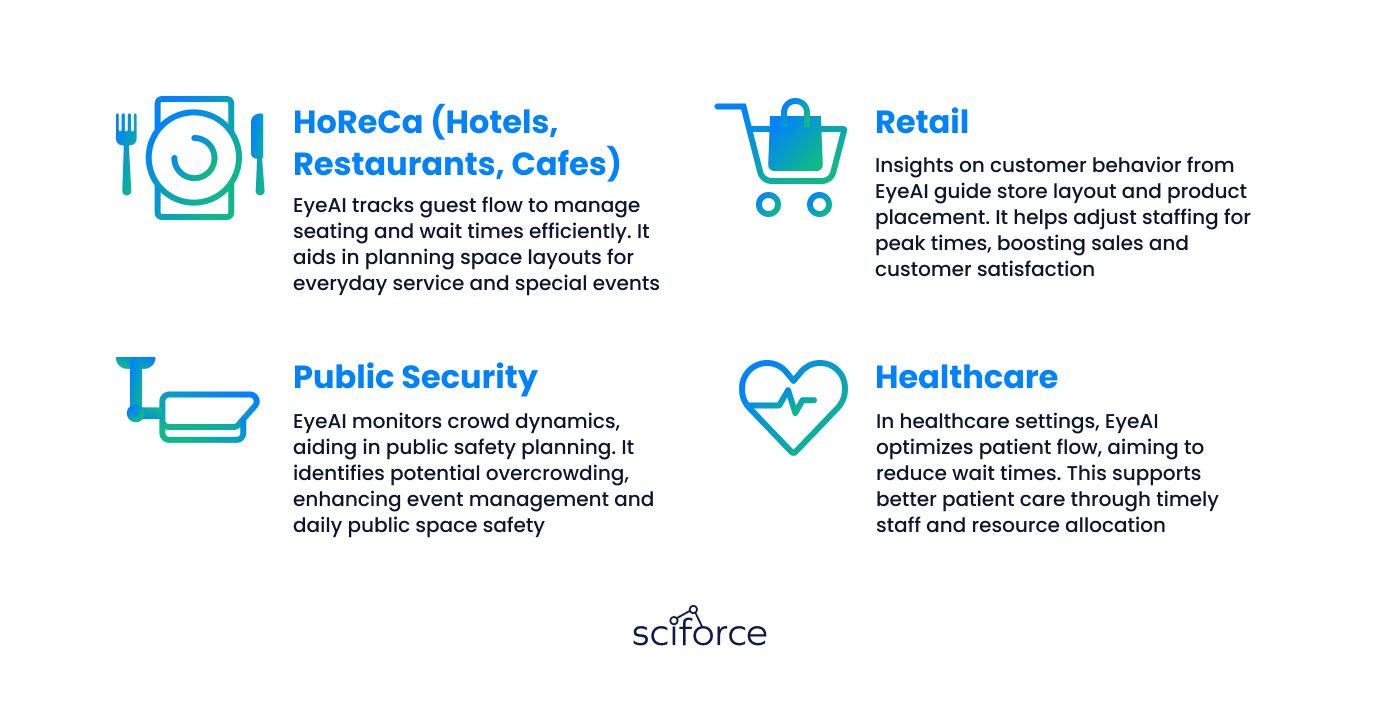
Natural Language Processing
Natural Language Processing (NLP) allows computers to handle and make sense of human language, letting them respond appropriately to text and spoken words. This automation of language-related tasks helps businesses improve accuracy, cut down on costs, and create new ways to grow and connect with customers.
Customer Service Chatbots NLP enables chatbots to answer customer questions instantly and accurately, improving satisfaction by cutting down wait times. This technology helps businesses expand their customer service without significantly increasing costs.
Sentiment Analysis for Market Research NLP examines customer opinions in feedback, social media, and reviews to gauge feelings towards products or services. These insights guide better marketing, product development, and customer service strategies.
Automated Document Processing NLP automates the handling of large amounts of text data, from emails to contracts. It simplifies tasks like extracting information, organizing data, and summarizing documents, making processes faster and reducing human errors.
Case: Recommendation and Classification System for Online Learning Platform
We improved a top European online learning platform using advanced AI to make the user experience even better. Knowing that personalized recommendations are key (like how 80% of Netflix and 60% of YouTube views come from them), our client wanted a powerful system to recommend and categorize courses for each user's tastes.
The goal was to make users more engaged and loyal to the platform. We needed to enhance how users experience the platform and introduce a new feature that automatically sorts new courses based on what users like.
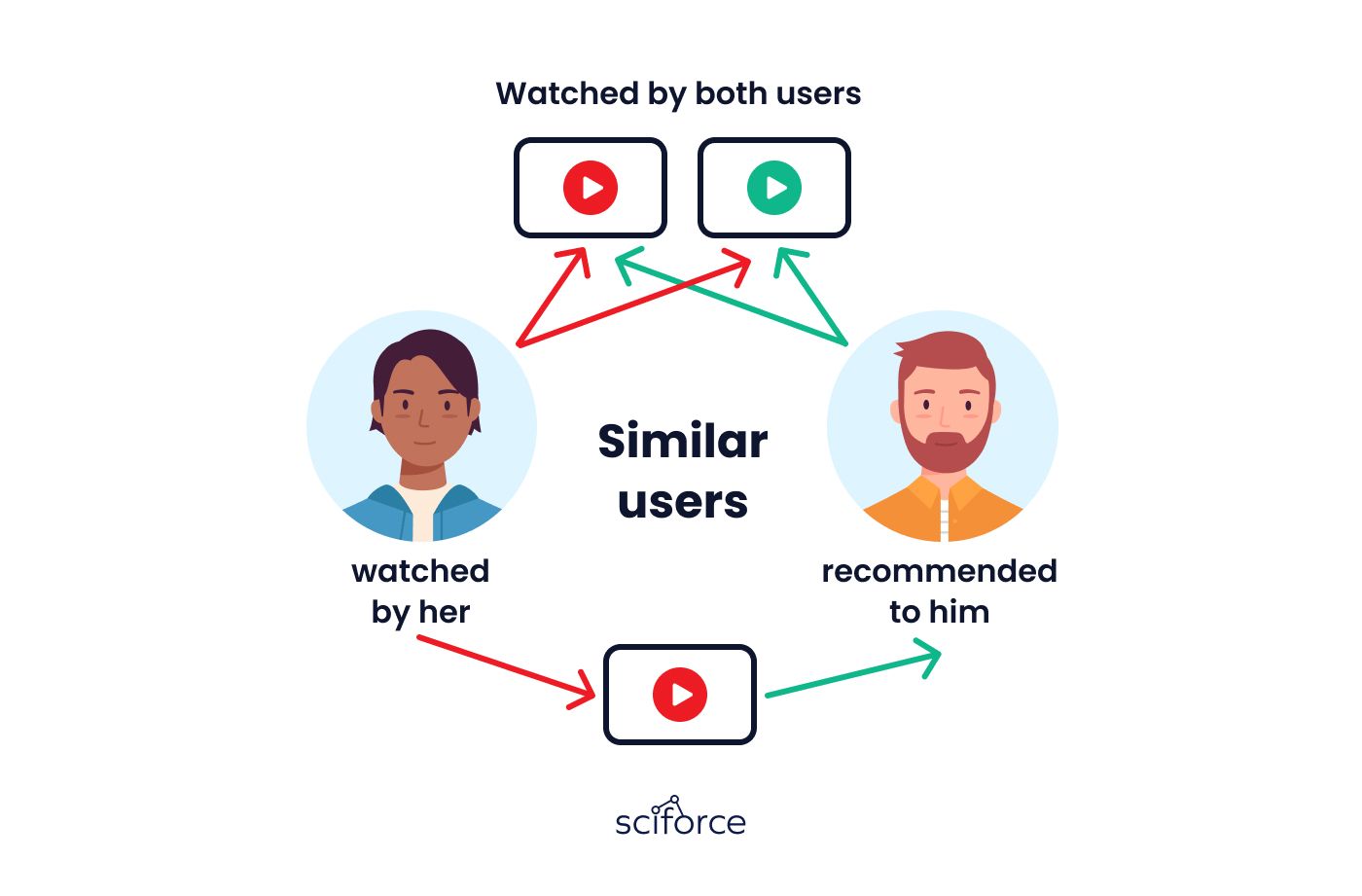
We approached this project with several steps:
- Gathering Data: First, we set up a system to collect and organize the data we needed.
- Building a Recommendation System: We created a system that suggests courses to users based on their preferences, using techniques that understand natural language and content similarities.
- Creating a Classification System: We developed a way to continually classify new courses so they could be recommended accurately.
- Integrating Systems: We smoothly added these new systems into the platform, making sure users get personalized course suggestions.
The platform now automatically personalizes content for each user, making learning more tailored and engaging. Engagement went up by 18%, and the value users get from the platform increased by 13%.
Adopting AI and ML is about setting bold goals, upgrading tech, smart resource use, accessing top data, building an expert team, and aiming for continuous improvement. It isn't just about successful competition — it's about being a trendsetter.
Here at SciForce, we combine AI innovations and practical solutions, delivering clear business results. Contact us for a free consultation.